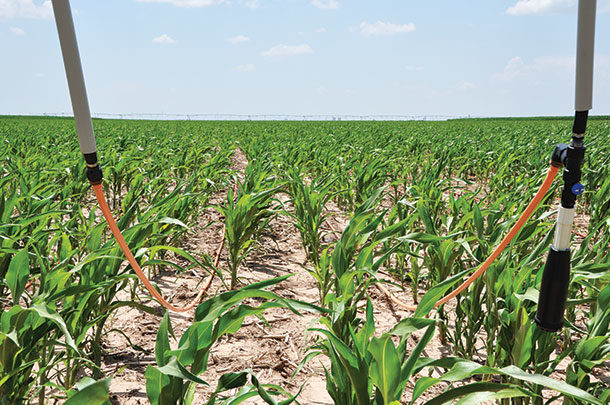In many areas of North America’s farm country, today’s farmers are contending with drought, depleted aquifers or demands on water from other forms of use.Interest in conserving water and finding more efficient means to achieve production goals in agriculture are of utmost importance today.
Irrigation delivery techniques have evolved substantially from man’s first efforts to manually deliver water to a crop. Through ongoing research and technology, we have developed methods of water delivery that are more efficient and cost-effective.
Over the past half century, sprinkler irrigation has gone through an evolution to become more efficient, moving from high-pressure, high-volume systems to low-pressure, low-volume systems in an attempt to achieve greater efficiency and production.

Another major advancement for irrigation efficiency is the research, development and mass production of drip irrigation. Interestingly, the idea of drip irrigation is far from new. The first documented use of drip irrigation dates back to ancient China.
In the late 19th century, drip irrigation began to develop in Germany through the use of subsurface clay pipe. In the 20th century, drip irrigation evolved to utilize perforated pipe. Perforated pipe was plagued with perforations becoming blocked. In answer to this, the first plastic emitter was developed in Israel in 1959. The emitter utilizes a larger and longer passageway at the point of delivery, reducing the problems with clogging and enhancing more even water distribution.
Stationary surface drip irrigation systems have been widely used for a multitude of crops in the arid southwestern regions of the U.S. since the latter half of the 20th century.
Over a decade ago, in keeping with irrigation’s long history of tireless efforts to become more efficient and productive, T-L Irrigation patented precision mobile drip irrigation (PMDI). PMDI integrates the proven efficiency (95 percent) of drip irrigation with the versatility and economics of center-pivot and linear delivery systems.
According to Dave Thom, vice president of sales for T-L Irrigation, “The concept was ahead of its time in 2001 and did not catch on.” But today’s demands for limited water are increasing, and with that comes the need for more efficiency.
In 2014, Netafim USA acquired the exclusive North American rights to bring PMDI to market as part of its complete drip irrigation system offering, providing producers water-shortage solutions for existing and new center-pivot and linear applications.
How does PMDI work? Drip lines are attached to the drops of a center-pivot or linear system, spaced every 30, 40 or 60 inches depending on soil type and requirements. As the system moves, it pulls the lines behind, delivering a gauged amount of water through the emitters of the drip line. The length of the drip line determines the amount of water delivered.

This eliminates the loss from wind drift, greatly reduces evaporation and allows the water to be banked in the soil in the root zone of the crop in a uniform pattern across the entire irrigated area. In the case of center-pivot application, the drip lines farthest from the center of the pivot are longer and may be 60 feet long at the end farthest from the center.
“Recent trials have shown that a PMDI system ... is capable of boosting yields substantially while using significantly less water than is typically applied by a conventional center-pivot system,” says Monty Teeter, CEO of Teeter Irrigation.
PMDI allows producers to accurately match water application and nutrient requirements to the crop’s needs and conditions. PMDI eliminates the wetting of leaves and stalks, further reducing loss due to evaporation. Because water is delivered behind the drive wheels, producers are able to eliminate deep wheel tracks and soil compaction. Also, this system eliminates issues of water pooling and collecting in low points of a field.
While most of the reports for the current PMDI systems are positive, as with most evolving visionary concepts there have been and are some negative issues associated with PMDI. In early trials, inadequate filtration led to emitter clogging. Earlier versions of the drip lines became tangled in the drive wheels and the drive mechanism of the center pivot.
Glenn Schur, a producer in Dumas, Texas, has had some sand collect in the last 1 or 2 feet of the drip-line hose but has been able to open the end plugs and flush the sand out, allowing the emitters to return to normal operation. He is currently using a 1-gallon-per-minute emitter, but is planning to change to a 2-gallon-per-minute emitter, which will reduce the length of the drip lines by half while delivering the same amount of water.
When asked about issues related to wind damage, Schur says that his farm is located in very windy country and he has “not had any trouble with wind.” A few drip lines have kinked when the pivot changed directions, but Schur states that this is easily remedied by simply unkinking the lines.
When asked about the industry’s response to some of these issues, Jim Hunt, regional sales manager with Netafim USA, says, “We are working on a few things, such as a new end plug for ease of line flushing as well as making the offering overall more complete from a Netafim solution perspective.
We will continue to evaluate the systems currently used in production agriculture for possibilities of reduced filtration requirements and anything that makes it easier to adopt and use.”
Currently, PMDI is being utilized for the production of wheat, alfalfa, potatoes, corn and sorghum in drought regions from the Great Plains to the Southwest.

Teeter cut corn for silage on his system near Ulysses, Kansas, in 2013 and 2014. The first year he had a 16 percent increase in yield and the second year a 20 percent increase. He says, “I used the same amount of water as with [my] pivot, but soil moisture monitoring showed about double the remaining wetted soil profile. So there was an opportunity to save water.”
When asked about alfalfa under PMDI, Hunt said, “We have a system in Grenada, Colorado, that had a yield improvement of 1 ton per acre for the season. That more than pays for the system in a single season. More experience will lead to a higher level of management and increased opportunity to save water, without question.”
Although PMDI has been available for over a decade, the promoters of this system have continued to work to improve and enhance PMDI. In 2014, Colorado State University performed a trial of the PMDI system, implementing enhancements on a farm in Walsh, Colorado.
In this study, corn was planted in a circular pattern on May 1 and 2; key nutrients, pre- and post-emergent herbicides were applied; and the entire pivot was irrigated with low-drift nozzles (LDN) until June 30. At that time, pressure-compensating drip-line hose was installed in sections between every other tower, and two towers were installed with drip-line hose and LDN alternating every other drop.
The pressure regulators were removed from the LDN. From June 30 to September 24, the crop was watered with what initially was estimated to be 20 inches per acre. The corn was harvested on November 24 and 25.
Kevin Larson, Brett Pettinger and Monty Teeter, authors of the study, report, “We expected larger yield differences between Dragon-Line and the LDN irrigation methods.
There was only 0.3 bushels per acre difference between these sprinkler irrigation delivery methods.” Later, Bob Jochens, Western Irrigation Supply House, Inc. (WISH), Colorado, calculates that due to the lack of pressure regulators on the LDN, the LDN actually released 30.6 percent more water to the crop than the pressure-compensated drip-line hose.

Hunt reports there is currently another trial being performed at Kansas State University in Garden City, and says, “They have some interesting data that is showing some significant advantage with PMDI on evaporative loss. Of course we still need to see yield data, but it looks promising.”
Glenn Schur is one of a number of producers participating in a water conservation project in his area involving 35 sites drawing water from the declining Ogallala Aquifer.
On the test site on Schur’s farm, there are four types of high-efficiency delivery systems, one of which is PMDI. In order to determine the amount of water reaching the root zone, three soil moisture probes have been placed within each of the zones watered by the different delivery systems.
The soil moisture data collected to date places PMDI in the “upper 50th percentile of performance, when compared to the others,” Schur says. “We are trying to figure out which system produces the best kind of crop under the least amount of water, with the most efficiency of all the systems. The PMDI looks to be performing rather well.” FG
Michael J. Thomas is a freelancer based in Idaho.
PHOTOS: Precision mobile drip irrigation is finding a place in alfalfa production, in addition to the more common use in row-crop production. With water availability concerns increasing, producers are looking at more efficient forms of irrigation to maintain yield. Photos courtesy of Monty Teeter.










